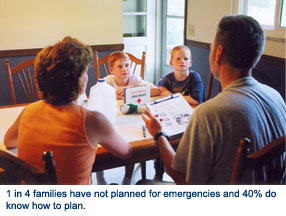Emergencies can strike anytime. A tornado, a flood or even a terrorist attack can change lives. Missouri families, communities, businesses and schools need to take steps today to prepare for an emergency. Preparing today can save lives!
Ready in 3 can help!
Endorsed by the American Red Cross, the State Emergency Management Agency and Missouri’s Office of Homeland Security, Ready in 3 focuses on three steps you can take to prepare for many kinds of emergencies.
Your family might not be together when emergency happens. That’s why it is important to have a plan in place. Sit down and talk to your family about how you will reach each other in different situations.
Make sure everyone in the family can get to a safe place and find each other in the event of an emergency. For instance, it is a great idea to designate two family meeting places, one in the neighborhood and one farther away.
Consider contacting the same friend or family member by telephone or e-mail. Think about making an out-of-town family member or friend the contact. It might be easier to make a long-distance telephone call instead of a local call during an emergency. It could be easier for an out-of-town person to connect separated family members.
You should plan for two situations – staying home or leaving. Deciding whether it is best to stay or go depends on the type of emergency. Officials may tell you what you need to do. In some cases, limited communication and information may require you to decide what is best for you and your family.
Know where to go if you have to leave. Sometimes it may not be safe to stay in your home. Plan where your family can meet. Know where you will go and how you will get there if you have to leave your home.
Family Safety Guides are available in print in English, Spanish, Bosnian and Braille and electronically in Romanian and Russian that outline the items that should be included in your emergency plan. Order your Family Safety Guide here.
Emergency Preparations for Individuals with Special Needs & Seniors
Emergency Preparations for Children in Schools
Emergency Preparations at Work
Prepare a kit for your home, car and at work.
For Your Home
During an emergency, you may not be able to get food or water for days or weeks, and your electricity may not be working. The following items should be part of your emergency kit and kept in a container that can be easily carried if you need to leave home:
- Water – families should set aside one gallon of water per person per day, to last three days.
- Canned or dried food – families should set aside a three-day supply of food per person. The food should be nonperishable items that don’t need to be cooked, such as tuna and crackers. Remember to include a manual can opener. If there’s an infant in the house, include formula and baby food.
- Battery-powered radio
- Flashlight
- Extra batteries for the radio and flashlight
- List of prescription medications
- First-aid kit
Tips
- For power outages, consider adding a corded telephone to your emergency kit if you are using only cordless telephones in your home currently.
- Learn how to use text messaging on your cell phone, most text messages will be sent even when you do not have cellular signal to make a call.
- Never use a generator indoors and install carbon monoxide detectors throughout your home.
For Your Car
Keep a small, portable emergency supply kit in your car at all times. You should include a gallon of water, several cans of food, a manual can opener, blankets, sleeping bags, money, and first-aid supplies.
At Work
Keep your own supply of fresh water and canned food, a flashlight, and battery-powered radio at your desk or in your locker. Everyone should consider keeping a change of clothes, and a pair of strong, practical shoes or boots at work.
For Your Pets
Make sure your pets have identification tags and up-to-date vaccinations. If you must leave home, bring your pet with you, if possible. You can plan ahead by creating a supply kit for your pet that includes extra food, water and medications. A carrier and leash will also be important. For cats, remember to include extra litter.
Listen for information about what to do and where to go during an actual emergency.
It is important to stay calm in an emergency. Get as much information about the situation as possible. If there is no electricity, make sure to have a battery-powered radio with extra batteries so you can listen for updates and instructions.
City, county, and state officials have developed emergency plans. In the event of an actual emergency, it’s important to follow their instructions and advice. They will provide you with the latest information.



Pingback: National Preparedness Month | Clinton County Emergency Management Agency
Pingback: Today is The Day Before | Clinton County Emergency Management Agency